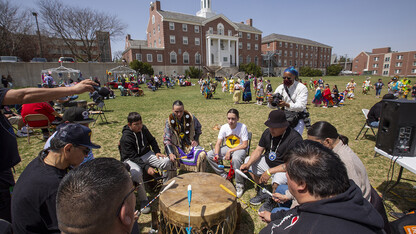· 9 min read
Nebraska in the national news: February 2019

Articles on a newly discovered link between the cervical microbiome and whether women develop pre-cancerous lesions led the 30-plus news stories featuring University of Nebraska–Lincoln faculty, students and programs in February.
Peter Angeletti, associate professor with the Nebraska Center for Virology, and colleagues have found a significant association between the composition of a woman’s cervical microbiome and the presence of pre-cancerous lesions on her cervix.
“There are certain families of bacteria that appear to be associated with the higher grades of pre-cancerous lesions,” Angeletti said. “What we know so far is that there is a relationship between the virus commonly associated with cervical cancer and the microbiome.”
Published Feb. 19 in mBio, the study found women with high-grade lesions had a more abundant and diverse microbial mix in their cervical microbiomes than women who had no lesions or less-serious lesions. Angeletti said the data suggests that Mycoplasma bacteria, in particular, may help promote the growth of HPV-related lesions.
The research team also included Charles Wood, director of the Nebraska Center for Virology; John West, research associate professor at the center; Samodha Fernando, associate professor of animal science at Nebraska, Cameron Klein, doctoral student at Nebraska; and Crispin Kahesa and Julius Mwaiselage of the Ocean Road Cancer Institute in Tanzania.
Stories on the research appeared on KMTV.com, HealthDay, WebMD and more than a dozen other media outlets.
Other coverage:
Anthony Starace, physics, wrote an article for the February issue of Physics Today on the history of the journal Reviews of Modern Physics. Published since 1929, Reviews of Modern Physics seeks to keep physicists updated on what is happening in the field’s many subdisciplines.
Josephine Potuto, law, former chair of the NCAA infractions committee, was interviewed for a Feb. 2 Lawrence Journal-World article on the NCAA’s recent ruling on the suspension of University of Kansas basketball player Silvio De Sousa. She said the language in the ruling makes it clear that further action could be coming.
Potuto was also interviewed for a Feb. 6 Kansas City Star story on Kansas Athletics’ designation of an Adidas representative as a “booster” during the De Sousa reinstatement case. She said the “booster” designation could change moving forward.
The university is using a federal grant to strengthen mental-health services and suicide-prevention programming on campus. An Associated Press article on the grant appeared in 14 Nebraska media outlets and more than three dozen others across the country.
Researchers from the University of Nebraska College of Law are working with colleagues from the University of Adelaide, University of New South Wales and Exeter University to assemble the Woomera Manual, which will contain all existing laws pertaining to space exploration, development and militarization. The team held its first meeting, in Lincoln, in late February. Futurism published an article on the project Feb. 4.
Max Perry Mueller, classics and religious studies, was cited throughout a Feb. 5 Daily Utah Chronicle article on the Church of Jesus Christ of Latter-day Saints’ history of revisionism regarding race relations.
Christina Yao, educational administration, was interviewed for a Feb. 5 Insider Higher Ed story on international students facing cultural insensitivity, discrimination and hostility on college campuses. Yao said she thinks outright hostility by faculty toward international students is uncommon, but the bigger issue is that faculty and administrators have high expectations that these students conform to how things are done in the U.S. “We’re a predominantly English-speaking country … and [the assumption is] everyone has to speak English,” she said.
Kelly Willemssens, graduate student in the School of Natural Resources, is featured in the Feb. 5 episode of the National Park Service’s Telemetry podcast. The episode is about the wetsalts tiger beetle found in Yellowstone National Park. Willemssens has spent the past two summers conducting research on the beetle as part of a project led by Leon Highley, insect ecologist with SNR.
John Hibbing, political science, was quoted in a Feb. 5 article in The Hill about the possibility of Sen. Ben Sasse (R-Nebraska) facing a primary challenger in 2020. Hibbing said aside from Sasse’s criticism of President Donald Trump and detachment from the repeal-ObamaCare debate he “has not left much room to his right” for an insurgent to exploit.
Hibbing, along with Kevin Smith, political science, Read Montague of Virginia Tech and John Alford of Rice University conducted an innovative experiment in the mid-2000s showing that liberals and conservatives react to repulsive pictures in drastically different ways. Conservatives are more sensitive to such images. The research was featured in an article on the topic in the March issue of The Atlantic.
Carrie Clark, educational psychology, is using functional MRI technology to capture brain activity while children learn mathematics. The goal is to understand how children learn effectively so math curricula can be developed to help all children succeed. Medical Xpress ran an article on the research Feb. 6.
Robert Hutkins, food science and technology, was interviewed for a Feb. 9 Guardian article examining the supposed health benefits of fermented foods. He said most of the clinical trials conducted on these foods have been funded directly by the companies trying to sell them, while there’s currently little or no regulation covering the labeling or manufacturing process. However, the National Institute of Health is currently funding clinical trials into various fermented products.
The university was included in a Feb. 10 Chronicle of Higher Education list of the top producers of Fulbright U.S. scholars and students. Fourteen students at Nebraska were awarded Fulbright grants for the 2018-19 academic year.
Jeannette Jones, history and ethnic studies, was quoted in a Feb. 10 USA Today article on anti-black racism in America.
Kenneth Kiewra, educational psychology, wrote a Feb. 11 piece for The Conversation on how parents can develop their children’s talents. He wrote that the appropriate conditions for success include five things: an early start, expert instruction, deliberate practice, a center of excellence, and singleness of purpose. The article was picked up by the Associated Press.
U.S. Sen. Ben Sasse; Nebraska students Grace Chambers, Kamryn Sannicks and Hunter Traynor; and Patrice McMahon, political science, director of the University Honors Program; discussed how to promote civil discourse and reconnect with people during the Charter Week kickoff event Feb. 11 at the NU Coliseum. Stories on the panel discussion appeared in 15 Nebraska media outlets, including the Lincoln Journal Star, and dozens of others.
On Feb. 12, The New York Times published a photo story by Wesaam Al-Badry, documenting his family’s resettlement experience in Lincoln. One of the photographer’s sisters, Shanon Al-Badry, is a senior civil engineering major at Nebraska. Another sister, Shams Al-Badry, is an academic adviser in the College of Education and Human Sciences.
Campus Technology published an article Feb. 13 on the new virtual reality project that allows people to tour the exterior of University Hall, the university’s first building. The project is a collaboration between NET and faculty members Heather Richards-Rissetto, anthropology, and Steve Kolbe, film and new media.
Radio New Zealand aired a review of Chigozie Obioma’s second novel, “An Orchestra of Minorities,” on Feb. 13. Obioma is an assistant professor of English at Nebraska.
He was listed among acclaimed Nigerian authors in a Feb. 14 BBC News article about Nigeria ahead of the country’s presidential election. The story was picked up by MSN News.
He also wrote a Feb. 22 opinion piece for The Guardian about Nigeria’s presidential election. He said he believes the new president is bound to fail given the current system, but certain steps — such as making all political offices unpaid and banning police escorts and security guards for non-government officials — could mitigate the chaos.
The Chronicle of Higher Education published a story in its Feb. 14 Teaching newsletter on Nebraska’s pop-up courses. The one-credit-hour, pass/no-pass classes — in subjects such as journalism and educational psychology — have proven popular. They allow students to examine emerging technologies and trends, learn new skills or pursue interests. Matt Waite, journalism; Amy Struthers, interim dean of journalism; and Kenneth Kiewra, educational psychology; were interviewed for the article.
Uche Jarrett, economics, was interviewed for a Feb. 16 Capital Public Radio story on the U.S. trade war with China potentially reaching customers.
The U.S. Drought Monitor — a joint effort of the National Oceanic and Atmospheric Administration, U.S. Department of Agriculture and the university’s National Drought Mitigation Center — was cited in a Feb. 17 Denver Post article on drought in Colorado. The map showed that western Colorado was ground zero for “extreme” and “exceptional” drought.
A Feb. 28 San Francisco Gate story on drought conditions improving in California also cited the Drought Monitor.
David Holding, agronomy and horticulture, and colleagues are developing lines of popcorn and sorghum featuring higher levels of lysine, an amino acid essential to the diets of humans and some livestock. Phys.org ran an article on the research Feb. 18.
Two programs in the university’s Jeffrey S. Raikes School of Computer Science and Management — “Innovate: The Raikes School Way” and “Girls Who Innovate” — were featured in a Feb. 18 Forbes article on STEM-focused summer programs for high school students.
Frans von der Dunk, space law, was featured on Inside Higher Ed’s Academic Minute on Feb. 21. He discussed how claims to the moon’s natural resources may present political problems in the near future. He said the 1967 Outer Space Treaty, which established the moon and other celestial bodies as global commons, needs to be strengthened to prevent conflicts.
An interdisciplinary team of faculty and students at Nebraska recently created the animated short film “Anna,” based on events in the life of Ann Williams, a 19th-century black slave who jumped from a window to try to keep her family together. She survived and eventually won freedom for herself and her family. BTN.com published a story and video on the project Feb. 26. Faculty members William G. Thomas III, humanities and history; Kwakiutl Lynn Dreher, English; and Michael Burton, textiles, merchandising and fashion design; and student Imani Brown were interviewed for the story.
Joe Louis, entomology, and colleagues have found that spraying a corn plant with one of its own compounds — 12-oxo-phytodienoic acid, or OPDA — can help deter the virus-carrying, pollination-disrupting insect known as the corn-leaf aphid. Stories on the research appeared in The Fence Post, High Plains Journal, Nebraska Farmer, Scottsbluff Star-Herald and 13 Ag Connection websites.
Dai Shizuka, biological sciences, was cited in a Feb. 27 Science News article on the egg-sneaking habits of some greater ani, a type of cuckoo found from Panama to the Amazon Basin. He said figuring out who sneaks and who doesn’t can provide insight into the balance of forces that promotes cheating or cooperation.
John E. Anderson, economics, was quoted in a Feb. 28 Bloomberg BNA story on an advisory panel working on recommendations to overhaul the New York City property tax system. The panel is looking into ways to ease the burden on low-income residents and others who might face higher tax bills.
Faculty, administration, student and staff appearances in the national media are logged at http://newsroom.unl.edu/inthenews. If you have additions to this list, contact Sean Hagewood at shagewood2@unl.edu or 402-472-8514. If you have suggestions for national news stories, contact Leslie Reed at lreed5@unl.edu or 402-472-2059.







